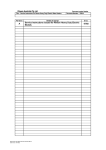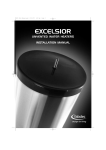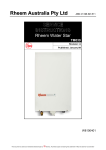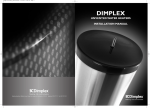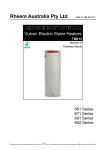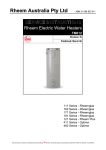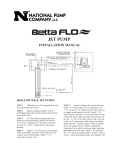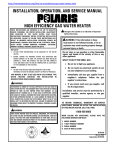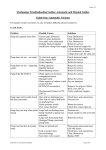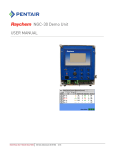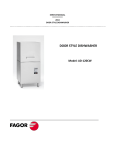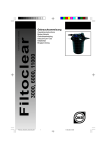Download AquaMAX E160 Series Service manual
Transcript
Aquamax Australia Pty Ltd ABN 17 138 189 689 AQUAMAX SERVICE MANUAL Stainless Steel Electric Water Heaters AQ0903010-A Revision: A Published: November 2012 E80 to E315 Series Contents Introduction .......................................................................................................................... 3 Safety Warning .................................................................................................................... 3 Heater Model Identification .................................................................................................. 3 Specifications....................................................................................................................... 4 Preventative Maintenance ................................................................................................... 4 Operation ............................................................................................................................. 5 Single Element Models .................................................................................................... 5 Twin Element Non-Simultaneous Models ........................................................................ 5 Components and their Function ........................................................................................... 6 Plumbing Diagrams ............................................................................................................. 7 Fault Finding ........................................................................................................................ 8 Common Faults................................................................................................................ 8 Fault Finding Charts....................................................................................................... 10 General Fault Finding Chart ....................................................................................... 10 Fault Finding Chart 1 – No Hot Water ........................................................................ 11 Fault Finding Chart 2 – Insufficient Hot Water / Water Not Hot Enough ..................... 14 Fault Finding Chart 3 – Water Too Hot....................................................................... 15 Fault Finding Chart 4 – Leaking Water Heater ........................................................... 16 Fault Finding Chart 5 – Noisy Water Heater............................................................... 16 Fault Finding Tests ........................................................................................................ 17 Electrical Insulation Testing ........................................................................................... 19 Component Adjustment Procedures .................................................................................. 20 Thermostat Adjustment .................................................................................................. 20 Component Replacement Procedures ............................................................................... 21 Replacement Parts Diagram – Single Element Models ................................................. 24 Replacement Parts List – Single Element Models ......................................................... 24 Replacement Parts Diagram – Twin Element Models .................................................... 25 Replacement Parts List – Twin Element Models ............................................................ 25 Document Revision History................................................................................................ 26 2 Introduction The information provided in this manual is based on the water heater being installed in accordance with the Installation Instructions provided with each water heater. Should you require further technical advice on an Aquamax Electric Water Heater, contact your nearest Aquamax Service Department where all genuine replacement parts are also available. Safety Warning The purpose of this Service Manual is to provide sufficient information to allow a person with the skills as required by the controlling Regulatory Authorities to carry out effective repairs to an Aquamax Electric Water Heater in the minimum of time. Safety precautions or areas where extra care should be observed when conducting tests outlined in this service manual are indicated by print in bold italics and/or a warning symbol. Take care to observe the recommended procedure. “Live” testing to be conducted. Personal Protective Clothing (PPE) must be worn to prevent the risk of electric shock. Isolate power before conducting the indicated test Hot surface or liquid. Personal Protective Clothing (PPE) must be worn to reduce the risk of scalding. General warning symbol. Observe the instructions accompanying the symbol. Heater Model Identification All identification numbers are designed to convey detailed information about the water heater to which it is attached. E 160 S 48 E – Electric series 160 – Rated hot water delivery in Litres S – Single Heating Unit T – Two Heating Units 18 – 1800W 24 – 2400W 36 – 3600W 48 – 4800W Element wattage SS - Stainless Steel Cylinder Model number, serial number and date of manufacture should be quoted in all correspondence. 3 SS Specifications Specification Storage capacity (L) Rated HW delivery (L) Boost capacity (L) (1) PTR valve rating (kPa) ECV rating (kPa) Max inlet pressure (kPa) Thermostat setting (°C) Water connections With ECV W/out ECV Top (1) Bottom(2) Inlet (Female) Outlet (Female) PTR valve (Female) E80 83 80 N/A 1400 1250 960 1120 N/A 60 ~ 75 E125 130 125 NA 1400 1250 960 1120 N/A 60 ~ 75 E160 165 160 46 1400 1250 960 1120 60 60 ~ 75 E250 260 250 69 1000 850 650 850 60 60 ~ 75 E315 315 325 79 1000 850 650 850 60 60 ~ 75 RP20 (¾”) RP20 (¾”) RP15 (½”) RP20 (¾”) RP20 (¾”) RP15 (½”) RP20 (¾”) RP20 (¾”) RP15 (½”) RP20 (¾”) RP20 (¾”) RP15 (½”) RP20 (¾”) RP20 (¾”) RP15 (½”) 240 Volts 50 Hz AC Electrical connection (1) (2) Twin element models only. Factory setting 70°C for twin element models and 65°C for all other single element models. Preventative Maintenance Annual Service It is suggested for peak performance that the water heater be serviced annually. 1. Check for discharge from the PTR valve. When the element is operating a small discharge of water may be evident. Operate the valve-easing lever to ensure the valve opens and resets properly. Always open and close the valve gently. 2. Check for discharge from the ECV if fitted. When the element is operating a small discharge of water may be evident. Operate the valve-easing lever to ensure the valve opens and resets properly. Always open and close the valve gently. 3. Check for leaks at all tank fittings. 4. Check for signs of excessive corrosion on the water heater jacket. 5. If an overflow tray is installed, check to ensure the overflow tray drain pipe is not blocked. 6. Isolate power to the water heater and check all electrical connections for signs of overheating due to poor connection. 7. Conduct an electrical insulation test on the water heater (refer to “Electrical Insulation Testing” on page 19). Major Five Year Service It is recommended that a major five year service be conducted on the water heater. 1. Replace pressure temperature relief valve (PTR). 2. Inspect and flush expansion control valve (if ECV fitted) and replace if required. 3. Check electric heating unit for excessive calcium build up or corrosion and replace heating unit if required. 4. Visually check water heater for any potential problems. 5. Inspect all plumbing and electrical connections. 4 Operation Single Element Models Water temperature is maintained via a thermostat switching the active conductor to an electric immersion element positioned towards the bottom of the cylinder. When the water temperature within the cylinder falls sufficiently, the thermostat contacts close suppling power to the element. Once the water temperature reaches the set point of the thermostat, the contacts open cutting power to the element. A double pole ‘manual reset’ over temperature cut out is incorporated into the thermostat to provide additional protection in the event the controlling thermostat contacts fail. The ECO contacts open between 80ºC and 88ºC. Twin Element Non-Simultaneous Models Water temperature is maintained via two electric immersion elements, one is positioned near the top of the cylinder and the other towards the bottom. Only one element is operational at any time (known as non simultaneous operation). A thermostat, positioned adjacent to each element is utilised to maintain water temperature. The top thermostat switches the neutral from the top element to the bottom element, this ensures only one element can be energised at a time. The top thermostat is factory set at 60ºC. The bottom thermostat switches the active to the bottom element only. Both thermostats incorporate a double pole ‘manual reset’ ECO to provide additional protection in the event the controlling thermostat contacts fail. Once the top thermostat senses a temperature of approximately 60ºC the thermostat contacts open the neutral circuit to the top element (between terminals 1 and 2), causing the top element to be de-energised, and close the neutral circuit to the bottom element (between terminals 1 and 5). When the water temperature at the bottom of the tank reaches the set point of the bottom thermostat, the thermostat contacts open cutting the active circuit to the bottom element. Under normal usage the top element is unlikely to operate, the water temperature being maintained by the bottom element. During periods of heavy use when the complete supply of hot water is depleted, the top element will operate to maintain the water temperature at the top of the tank (above the top element). When the bottom element is connected to an off peak tariff full recovery of the tank will occur whenever power from the off peak tariff is available, usually overnight. 5 Components and their Function Temperature and Pressure Relief Valve A valve designed to provide automatic relief by discharging water in case of excessive temperature, pressure or both. Never fit a PTR Valve with a pressure rating greater than that indicated on the product-rating label. Pressure Limiting Valve (P.L.V.) A valve that controls its outlet pressure to a predetermined limit. Stainless Steel Inlet Tube and Diffuser Assembly A stainless steel tube assembly is installed in the cold water inlet of the water heater cylinder to assist with stratification. Thermostat A device, responsive to temperature, which controls the supply of electrical energy to the element to maintain the stored water at the required temperature. Non-simultaneous (Top) Thermostat – Twin Element Models A device, responsive to temperature, which controls the supply of electrical energy to the top element to maintain the stored water at the required temperature. It also switches the neutral supply between the top and bottom elements to ensure only one element can be operational at any time. This is known as non-simultaneous operation. Over Temperature Energy Cut Out (E.C.O.) A temperature-sensing device in combination with the thermostat that automatically cuts off the supply of electrical energy to prevent excessive water temperature occurring. This device will not reset automatically but may be manually reset once temperatures have fallen to a safe level. DETERMINE CAUSE OF OPERATION. Heating Unit (Element) A tubular device containing an electric resistance element that converts electrical energy to heat. Standard ratings are 1.8, 2.4, 3.6, and 4.8 kW. 6 Plumbing Diagrams The following information and plumbing diagrams are provided as a guide only. For more information refer to the relevant Installation Instructions. Two Temperature Zone Plumbing Diagram Circulated Flow & Return Plumbing Diagrams For circulated hot water flow and return systems, a temperature limiting device can only be installed on a dead leg which branches off the circulated hot water flow and return pipe. Installing a temperature limiting device in the circulated flow and return pipe work, or circulating tempered water from a temperature limiting device may cause water to be delivered to ablution areas at a temperature exceeding the requirements of AS/NZS 3500.4. 7 Fault Finding Common Faults When a complaint is lodged about the performance of a hot water system there are a number of causes that should be checked and eliminated. In an attempt to pinpoint the most likely cause it is important to discuss with the customer their reasons for the complaint, the duration of the problem, any change in circumstances or usage and recent weather conditions. This information in conjunction with the following listed common complaints will assist you in locating the most likely cause. All procedures assume there is water flowing through the water heater. Excessive hot water usage The complaints of insufficient hot water and no hot water can on many occasions be attributed to hot water usage exceeding the capacity of the water heater to provide hot water. When first attending a call of this nature it is essential to establish the probable hot water usage by querying the usage habits of the household and compare this with the potential delivery of the model water heater installed. It can then be established if the usage is within or outside the capacity of the model. The areas to look at for excessive usage are: 1. Automatic washing machines. 2. Showers exceeding 12 litres/minute for mixed water and 5 minutes in duration. 3. Two or more showers operating at the same time. 4. Change of occupancy or number of persons increased. 5. High water pressure area (Excessive pressure relief valve discharge). 6. Plumbing leaks. 7. Thermostat temperature setting. 8. Crossed connection. Discoloured water This may be the result of discoloured water entering from the cold water mains. Check if the cold water is also discoloured. Water hammer A water heater will not cause water hammer, however valves associated with the water heater may be the source of the problem i.e. cold-water stopcock, non-return valve or relief valve. Most water hammer problems are associated with plumbing, hot and cold or appliances i.e. solenoid valves, ballcocks, loose pipes, sharp angles in pipe work, faulty or worn valve parts, loose tap washers or neighbouring equipment. High water pressure areas will have more complaints of this nature and the use of a pressure-limiting valve (PLV) to reduce the household cold-water pressure will usually solve most problems. 8 Hot water plumbing leaks If hot water has not been used for a period of time, feeling the temperature of the hot water line may give an indication of water flow if the pipe is warm. The method of checking for plumbing leaks is: 1. Turn off the stopcock on the cold water supply to the water heater. 2. Open a hot tap to ensure the flow of water stops. This will confirm the stopcock is operating correctly. 3. Turn off the hot tap. 4. Turn on the stopcock to make up the water pressure in the cylinder and then turn the stopcock off again. 5. Wait approximately 5 minutes then do either of the following: a. With your ear close to the stopcock turn it on slightly and listen for any water passing. If there are no leaks, water should not pass. b. Open a hot tap while listening for any pressure release. If there is a pressure release there will be no leaks in the plumbing system. Mixing or crossed connections If an automatic dishwasher, washing machine, flick mixer tap, tempering valve or thermostatic mixing valve is installed there is always the possibility that the cold water could mix with the hot water through a faulty or incorrectly installed valve. This is referred to as a cross connection. The complaints of insufficient hot water, water not hot enough or excessive discharge from the pressure relief valve may be attributed to a cross connection. The method of checking for a cross connection is: 1. Turn off the stopcock on the cold water supply to the water heater. 2. Open a hot tap. If water flow is persistent and cold then a cross connection exists. 9 Fault Finding Charts General Fault Finding Chart Chart 1 2 3 4 5 Complaint No hot water Insufficient hot water / Water not hot enough Water too hot Leaking water heater Noisy water heater 10 Page 11 14 15 16 16 Fault Finding Chart 1 – No Hot Water Fault Finding Chart 1.1 11 Fault Finding Chart 1.2 Fault Finding Chart 1.3 12 Fault Finding Chart 1.4 13 Fault Finding Chart 2 – Insufficient Hot Water / Water Not Hot Enough 2 INSUFFICIENT HOT WATER / WATER NOT HOT ENOUGH Has the usage pattern changed recently? i.e. additional appliances or people using hot water. Is the heater of sufficient size for the customers on going needs? Refer to sizing guide. YES NO YES Recommend a water heater of sufficient capacity to meet the customers needs. NO Is the PTR valve continuously discharging water? Is the water supply pressure more than 80% of the PTR valve rating? YES YES NO Is the correct PTR valve fitted? NO YES Confirm a recent large draw off of hot water has not depleted the hot water supply temp. Allow time for the heater to recover (Note: for models on off peak tariffs this may not occur until the next day). Has there been a recent large draw off of hot water? YES If water heater has a tempering valve installed: Typically the hot inlet temperature to the tempering valve must be 10º higher than the required outlet temperature. Bottom thermostat if twin element model Is cylinder water temp 8ºC less than the thermostat setting? YES Is water heater a single or twin element model? NO Single element model Twin element model Is the element(s) installed in the correct orientation? Check for crossed water connection. Replace PTR valve. Repair any leaks. Isolate crossed connections. YES NO NO Fit pressure limiting valve if not already installed. Existing pressure limiting valve faulty – Replace. Faulty PTR valve – Replace. Replace PTR valve with one of the correct pressure rating. NOTE: Do not use reconditioned PTR valves NO Are there any plumbing leaks, crossed connections or dripping taps? Recommend a hot water usage pattern that will suit the water heater and the customers needs 1.2 1.3 NO Install element(s) in correct orientation. NO Check inlet diffuser is not restricted, missing or damaged. Check dip tube is not missing broken or incorrectly fitted. YES Clean or replace tempering valve filters. Refer to manufacturers instructions for tempering valve. NO Replace tempering valve. Refer to manufacturers instructions for tempering valve. YES Is a tempering valve installed? YES Are tempering valve filters blocked? NO Is tempering valve outlet water temp approx 48ºC? Normal Operation of tempering valve Tempering valves are generally set to deliver water at 48 - 50ºC. YES Depending on the length of pipe work and insulation to the fixture(s), water temperature can be lower due to heat loss. NOTE: AS/NZS 3500 Part 4 only requires fixtures used for ablution purposes to be tempered. If practical a 2 zone plumbing solution may be offered. 14 Check inlet diffuser is not restricted, missing or damaged. Check dip tube is not missing broken or incorrectly fitted. Fault Finding Chart 3 – Water Too Hot 15 Fault Finding Chart 4 – Leaking Water Heater Fault Finding Chart 5 – Noisy Water Heater 16 Fault Finding Tests Fault Finding Tests 1 – 3 Test 1 – Single Element Models Test 1 – Twin Element Models Using a multimeter set on the AC voltage scale, measure between the Active terminal ‘A’ and the Neutral terminal ‘N’ on the terminal block. Using a multimeter set on the AC voltage scale, measure between the off peak Active terminal ‘A1’ and the Neutral terminal ‘N’ on the terminal block. Then measure between the boost Active terminal ‘A2’ and the Neutral terminal ‘N’ on the terminal block. The following results should be obtained: Normal voltage is 240 Volts AC. Active ‘A1’ to Neutral ‘N’ – 240 Volts AC. Active ‘A2’ to Neutral ‘N’ – 240 Volts AC. Test 2 – ST Thermostat Test 3 – ST Thermostat Using a multimeter set on the resistance scale, measure between the thermostat terminals marked ‘3’ and ‘4’ (bottom thermostat on twin element models). Using a multimeter set on the resistance scale, measure between the thermostat terminals marked ‘1’ and ‘2’ (bottom thermostat on twin element models). Normal resistance is less than 1 ohm when Normal resistance is less than 1 ohm when the ECO contacts are closed. the thermostat contacts are closed. 17 Fault Finding Tests 4 – 7 Test 4 Test 5 ST thermostat shown Single element model shown Disconnect both element wires from the thermostat and using a multimeter set on the resistance scale, measure between the two disconnected element wires. Using a multimeter on the resistance scale, measure between the Active wire ‘A’ and the Neutral wire ‘N’ on the terminal block. Note: If model is a twin element model, mark, disconnect and twist ‘A1’ and ‘A2’ actives together to form one active connection for testing purposes. Normal resistance is as follows: 1.8kW 2.4kW 3.6kW 4.8kW element: 29 ~ 35Ω. element: 22 ~ 26Ω. element: 15 ~ 17Ω. element: 11~ 13Ω. Normal overall resistance when thermostat is closed will depend on element size. Refer to test results for test 4. Test 6 – ST Thermostat Test 7 – ST Thermostat Using a multimeter set on the resistance Using a multimeter set on the resistance scale, measure between the top thermostat scale, measure between the top thermostat terminals marked ‘1’ and ‘2’. terminals marked ‘3’ and ‘4’. Normal resistance is less than 1 ohm when Normal resistance is less than 1 ohm when the neutral contact to the top element is the ECO contacts are closed. closed. 18 Fault Finding Test 8 Test 8 – ST Thermostat Using a multimeter set on the resistance scale, measure between the top thermostat terminals marked ‘1’ and ‘5’. Normal resistance is less than 1 ohm when the neutral contact to the bottom element is closed. Electrical Insulation Testing There are three basic test procedures that should be carried out when the operation and function of a water heater’s electrical system is in doubt. Personal Protective Equipment should be worn when conducting this procedure to reduce the risk of electric shock. To check insulation resistance of the water heater Neutral Circuit (reading not to be below 1 mega-ohm). 1. Isolate the power supply to the water heater by removing fuse or switching off circuit breaker. Confirm with a multi-meter across the Active(s) and Neutral wires at the terminal block that voltage is not present (refer to “Test 1” on page 17). 2. Once satisfied, disconnect the power supply active and neutral wires from the terminal block. Note: If model is a twin element model, mark and disconnect both active wires (marked ‘A1’ and ‘A2’). 3. Connect megger leads to the neutral of the water heater wiring and earth. 4. Operate megger on 500 VDC setting. A reading above 1 mega-ohm should be obtained. 5. If a reading below 1 mega-ohm is obtained, all component parts will need to be individually tested to locate the fault (refer to “fault finding chart 1.1” on page 11). 19 To check insulation resistance of the water heater Active Circuit (reading not to be below 1 mega-ohm). 6. Connect megger leads to the active of the water heater wiring and earth. Note: If model is a twin element model, mark, disconnect and twist ‘A1’ and ‘A2’ actives together to form one active connection for testing purposes. 7. Operate megger on 500 VDC setting. A reading above 1 mega-ohm should be obtained. 8. If a reading below 1 mega-ohm is obtained, all component parts will need to be individually tested to locate the fault (refer to “fault finding chart 1.1” on page 11). To check “Continuity” of the water heater electrical circuit. 9. Set megger to resistance scale or multimeter to x1 resistance scale and measure between the active and neutral wires on the water heater. Note: If model is a twin element model, keep ‘A1’ and ‘A2’ actives twisted together to form one active connection for testing purposes (previously performed in step 6). 10. If a reading of less than 10 ohms or greater than 35 ohms is obtained, all electrical component parts will need to be individually tested to locate the fault (refer to “Test 5” on page 18). 11. Reconnect power supply active cable to ‘A’ terminal and neutral cable to ‘N’ terminal at heater terminal block. Note: If model is a twin element model, untwist water heater ‘A1’ and ‘A2’ active wires and reconnect to terminal block as per markings. 12. Replace fuse or reset circuit breaker. Note: If continuing with diagnosis procedures do not replace fuse or reset circuit breaker. Component Adjustment Procedures Thermostat Adjustment The main (bottom) thermostat has been factory preset to 70°C for twin element models and 65°C for all other single element models. It is possible to adjust this thermostat (60 ~ 75°C) but is recommended that the main thermostat’s maximum setting does not exceed 70°C. The boost (top) thermostat is set to 60°C and is non adjustable. To adjust the main thermostat: Personal Protective Equipment should be worn when conducting step 3 of this procedure to reduce the risk of electric shock. 1. 2. 3. 4. 5. 6. Isolate the power supply to the water heater by removing fuse or switching off circuit breaker. Remove lower access cover. Confirm with a multi-meter between each Active and Neutral at the terminal block that voltage is not present. Turn thermostat temperature adjustment dial clockwise to increase temperature setting or anticlockwise to decrease temperature setting. Replace lower access cover. Restore the power supply to the water heater. 20 Component Replacement Procedures Draining the Water Heater (Procedure 1) Elevated temperatures may be present during the draining process. Personal Protective Equipment should be worn to prevent the risk of scalding. Personal Protective Equipment should be worn when conducting step 3 of this procedure to reduce the risk of electric shock. 1. Isolate the power and water supplies to the water heater and remove lower access cover. 2. Relieve pressure from the water heater through PTR valve or a hot tap. 3. Confirm with a multi-meter between each Active and Neutral at the terminal block that voltage is not present. 4. Disconnect the cold water supply pipe. 5. Fit a drain hose to the cold water connection and run the other end to a drain or safe location. 6. Open the temperature and pressure relief valve to allow air into the system. Pressure & Temperature Relief Valve (Procedure 2) Never fit a PTR valve with a rating higher than that indicated on the water heater rating plate. Do not use reconditioned PTR valves. 1. Partially drain the water heater (refer to procedure 1). 2. Remove the drain line from the PTR valve. 3. Unscrew the PTR valve and remove. 4. Confirm the replacement PTR valve is the correct rating and refit using thread tape. 5. Refit the drain line. 6. Close the hot tap and restore water supply. 7. Check PTR valve thread for leaks. 8. Operate the PTR valve lever to reset relief drain. 9. Purge air from the system through hot taps. 10.Restore the power supply to the water heater. Top Thermostat - Non-Simultaneous (Procedure 3) Personal Protective Equipment should be worn when conducting step 2 of this procedure to reduce the risk of electric shock. 1. Isolate the power supply to the water heater and remove upper and lower front covers. 2. Confirm with multi-meter between each Active and Neutral at the terminal block that voltage is not present. 3. Remove the thermostat protective cover and disconnect the wiring from the thermostat (Note wiring positions). 21 4. Slide thermostat vertically out of clamp. 5. Remove any scale or corrosion from the cylinder surface. 6. Slide replacement thermostat into place behind clamp and connect wiring to appropriate points (refer to “Wiring Diagrams” section on page Error! Bookmark not defined.). Note: Ensure thermostat face is in good contact with cylinder surface. 7. Check water heater internal wiring insulation for cracking. 8. Refit the thermostat protective cover and upper access cover securely. 9. Conduct an electrical insulation test on the water heater (refer to “Electrical Insulation Testing” on page 19). 10.Replace lower access cover and restore the power supply to the water heater. Bottom Thermostat – Trade Adjustable (Procedure 4) Personal Protective Equipment should be worn when conducting step 2 of this procedure to reduce the risk of electric shock. 1. Isolate the power supply to the water heater and remove access cover. 2. Confirm with multi-meter between each Active and Neutral at the terminal block that voltage is not present. 3. Remove the thermostat protective cover and disconnect the wiring from the thermostat (Note wiring positions). 4. Slide thermostat vertically out of clamp. Note the current temperature selected. 5. Remove any scale or corrosion from the cylinder surface. 6. Slide replacement thermostat into place behind clamp, set temperature to that noted in step 4 and connect wiring to appropriate points (refer to “Wiring Diagrams” section on page Error! Bookmark not defined.). Note: Ensure thermostat face is in good contact with cylinder surface. 7. Check water heater internal wiring insulation for cracking. 8. Conduct an electrical insulation test (refer to “Electrical Insulation Testing” on page 19). 9. Refit the thermostat protective cover and the lower access cover. 10.Restore the power supply to the water heater. Element – Top and Bottom (Procedure 5) Elevated temperatures may be present during element removal process. Personal Protective Equipment should be worn to prevent the risk of scalding. When a fault or leak is traced to the element, the water heater should be drained to prevent damage to flooring or floor coverings by accidental flooding. 1. Drain the water heater (refer to procedure 1). 2. When the water heater is drained, undo the four element screws, removing thermostat clamp first. 3. Withdraw the element. Care must be taken to ensure the loop of the element does not catch in the cylinder opening and open out inside the cylinder. 22 NOTE: Do not cut off the element and leave a portion inside the cylinder. 4. Clean around cylinder fitting, fit a new gasket to the new element and slide the element into the cylinder (reverse to step 3) taking care that it is in the correct orientation. Refer to element flange for orientation directions. Note: Never reuse old element gaskets. 5. Replace screws and thermostat clamp and tighten. Note: The element retaining screws are tightened only until the return edge bottoms on the tank flange – do not over tighten. 6. The earthing of the internal storage cylinder relies on a good electrical contact between the metal surround of the element flange and the cylinder barrel flange. An earth continuity test should be performed whenever an element or element gasket is replaced, adjusted or serviced in any way. This continuity test is performed between the heaters internal storage cylinder and the main earth terminal of the water heater with a resulting reading of not more than 0.5 ohms as required by AS/NZS 3000 6.3.3.2. 7. Restore cold water supply and fill the storage tank. Release air by gently lifting the easing lever on the PTR valve until water runs from the drain or opening hot taps. 8. Check for water leaks around the element flange. 9. Conduct an electrical insulation test (refer to “Electrical Insulation Testing” on page 19). 10. Replace access cover securely and restore the power supply to the water heater. 23 Replacement Parts Diagram – Single Element Models Replacement Parts List – Single Element Models Item 1 2 3 4 5 6 7 8 9 10 Description PTR valve 1000 kPa x ½” PTR valve 1400 kPa x ½” Thermostat (bottom) 1800W Incoloy 2400W Incoloy Element 3600W Incoloy 4800W Incoloy Access cover Seal element Retainer thermostat Electrical safety shield Screw, element M8 x 20 Hex Washer star Terminal block, 2 way (Single element models) Part Number AQ0262003 AQ0262006 AQ0203015 AQ0200572 AQ0200573 AQ0200575 AQ0200576 AQ2053002 050704 102501 AQ0203017 AQ0100113 AQ0104203 AQ0211501 24 Remarks (250L – 315L) (80L – 160L) Adjustable 60 ~ 75°C (80L - 160L) (80L - 250L) (80L – 315L) (125L – 315L) (80L - 315L) (80L - 315L) (80L - 315L) For thermostat Steel Zinc Plated Zinc Plated (80L - 315L) Replacement Parts Diagram – Twin Element Models Replacement Parts List – Twin Element Models Item 1 2 3 5 5 6 7 8 9 10 11 Description PTR valve 1000 kPa x ½” PTR valve 1400 kPa x ½” Thermostat boost (top) Thermostat (bottom) 1800W Incoloy 2400W Incoloy Element 3600W Incoloy 4800W Incoloy Access cover Seal element Retainer thermostat Electrical safety shield Screw, element M8 x 20 Hex Washer star Terminal block, 3 way (Twin element models) Part Number AQ0262003 AQ0262006 AQ0203016 AQ0203015 AQ0200572 AQ0200573 AQ0200575 AQ0200576 AQ2053002 050704 102501 AQ0203017 AQ0100113 AQ0104203 AQ0211501 25 Remarks (250L – 315L) (160L) 60°C non adjustable Adjustable 60 ~ 75°C (160L) (160L - 250L) (160L – 315L) (160L – 315L) (160L - 315L) (160L - 315L) (160L - 315L) For thermostat Steel Zinc Plated Zinc Plated (160L - 315L) Document Revision History Title: Aquamax Stainless Steel Electric Service Manual Revision A Details of change Service Manual issued Revision Date: 15/11/2012 Document No: AQ0903010-A D.O.I. 15/11/12 AQ0903010-A NOTE: Every care has been taken to ensure accuracy in preparation of this publication. No liability can be accepted for any consequences, which may arise as a result of its application. 26


























